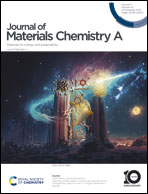A nature-inspired strategy towards superhydrophobic wood†
Abstract
Plant polyphenols are a type of natural substance widely present in plants, which can form three-dimensional metal-phenolic networks (MPNs) via chelation with metal ions, thereby enabling the construction of functional material coatings. Herein, a novel and straightforward approach was employed to prepare superhydrophobic wood by utilizing a nature-inspired strategy. The main component of wood polyphenols, rutin, was employed to create MPNs with various metal ions (Fe(III), Fe(II), Al(III), and Cu(II)), resulting in the formation of a rough hierarchical structure on the wood surface, followed by a polydimethylsiloxane (PDMS) modification. Polyphenol-free wood was impregnated with rutin solution and then complexed with metal ions. Taking rutin-Fe(III)-based superhydrophobic poplar as an example, it showed excellent performance in self-cleaning and anti-fouling. In addition, it showed excellent resistance to acids and alkalis and organic solution impregnation. The superhydrophobic coating maintained robust mechanical durability under the action of long-term placement, ultrasonic washing, tape peeling and sandpaper grinding as well. We believe that the superhydrophobic wood modified with rutin–metal complexes and PDMS is considered environmentally friendly, cost-effective, sustainable, and easily scalable. Thus, it exhibits immense potential for practical applications in indoor and outdoor decoration as well as building materials.



 Please wait while we load your content...
Please wait while we load your content...